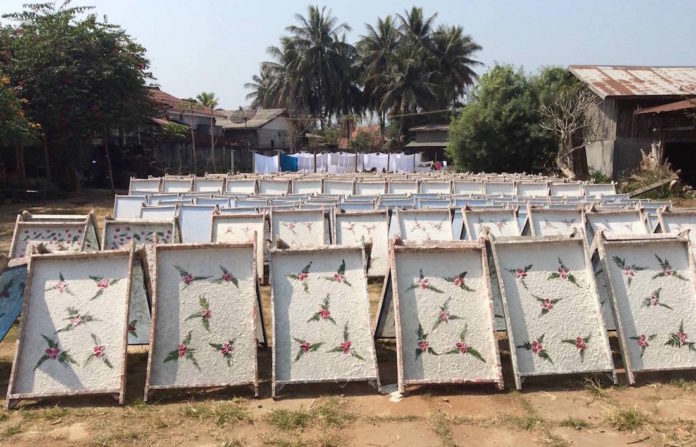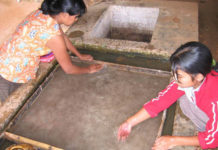In Laos, mulberry bark paper (mulberry bark paper in Lao: jia po saa or jia saa; mulberry bark paper in Khmu: salae) has different uses, ranging from traditional to modern. For example, jia saa composes festival decorations, gift boxes, greeting cards, lantern covers, religious texts and wrapping paper. The paper is lightweight and comes in different textures and dimensions. It ranges from flexible and translucent to stiff and opaque. The paper is dyed different colours and is decorated with leaves and flower petals.
 The variety of mulberry shrub-like tree (Broussonetia papyrifera also known as Morus papyrifera L) is called ton po saa in Lao. The paper mulberry tree is indigenous to Laos and other parts of Asia. Regenerating the soil, paper mulberry trees grow easily in fallow swidden fields. Farmers cultivate these trees for commercial production of jia saa in other areas such as Sainyabouly Province. Since the paper mulberry trees grow quickly (mature in 6-12 months), the production of paper is environmentally sustainable.
The variety of mulberry shrub-like tree (Broussonetia papyrifera also known as Morus papyrifera L) is called ton po saa in Lao. The paper mulberry tree is indigenous to Laos and other parts of Asia. Regenerating the soil, paper mulberry trees grow easily in fallow swidden fields. Farmers cultivate these trees for commercial production of jia saa in other areas such as Sainyabouly Province. Since the paper mulberry trees grow quickly (mature in 6-12 months), the production of paper is environmentally sustainable.
To make jia saa, 3-5 branches are cut from a tree and outer bark is stripped from the branches. The strips of inner bark remain and are set out to dry before being soaked in a tub of water. The bark is boiled in a mixture of water and potash. After boiling, the strips are pounded to break down the fibres. The pulp can be dyed at this stage.
Artisans utilise pieces of cloth or wire mesh stretched over wood frames to create jia saa. Some pulp is placed in a tub filled with water, and the frames are swept in and out of the vat, allowing some pulp to adhere to the stretcher frame. They add more pulp when required. Other artisans pour the pulp/water mixture over the frames using ladles. Decorative elements, such as flowers and leaves, can be placed on top of the wet pulp. The trays are placed in the sun to dry. In the hot season of Laos, the paper dries in a couple of hours.
Despite the increase in demand via the growth of tourism and export to Asian countries such as Thailand, the production of jia saa remains in the hands of families in Laos. International organisations have funded mulberry paper projects, such as UNINDO in Oudomxay Province and FORCAP in Luang Phabang Province. The production of jia saa is possible to observe in Sang Khong Village, located a couple of kilometres upriver from Luang Phabang town. One family business offers a wide range of handmade paper products. Located in village centre, the family of Mr. Tanh Manipoun demonstrates the papermaking process. A traditional use of paper continues in the bun lai heua fai or the paper lantern boat festival held in Luang Phabang held in October annually.





